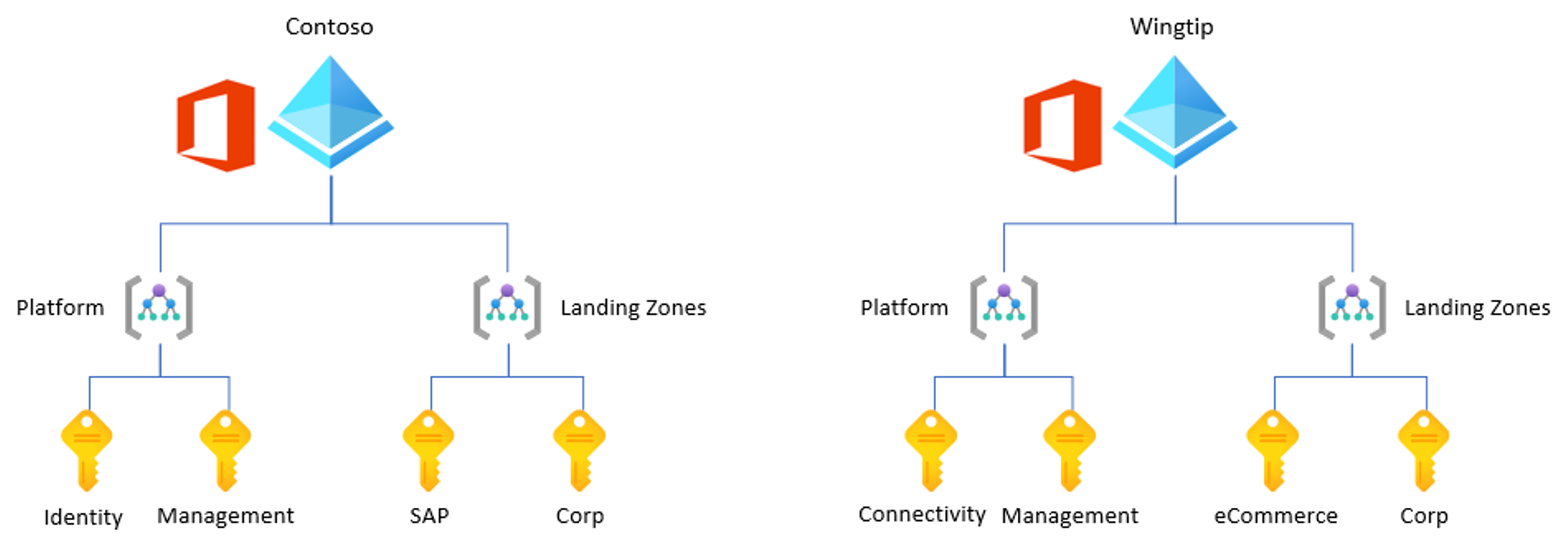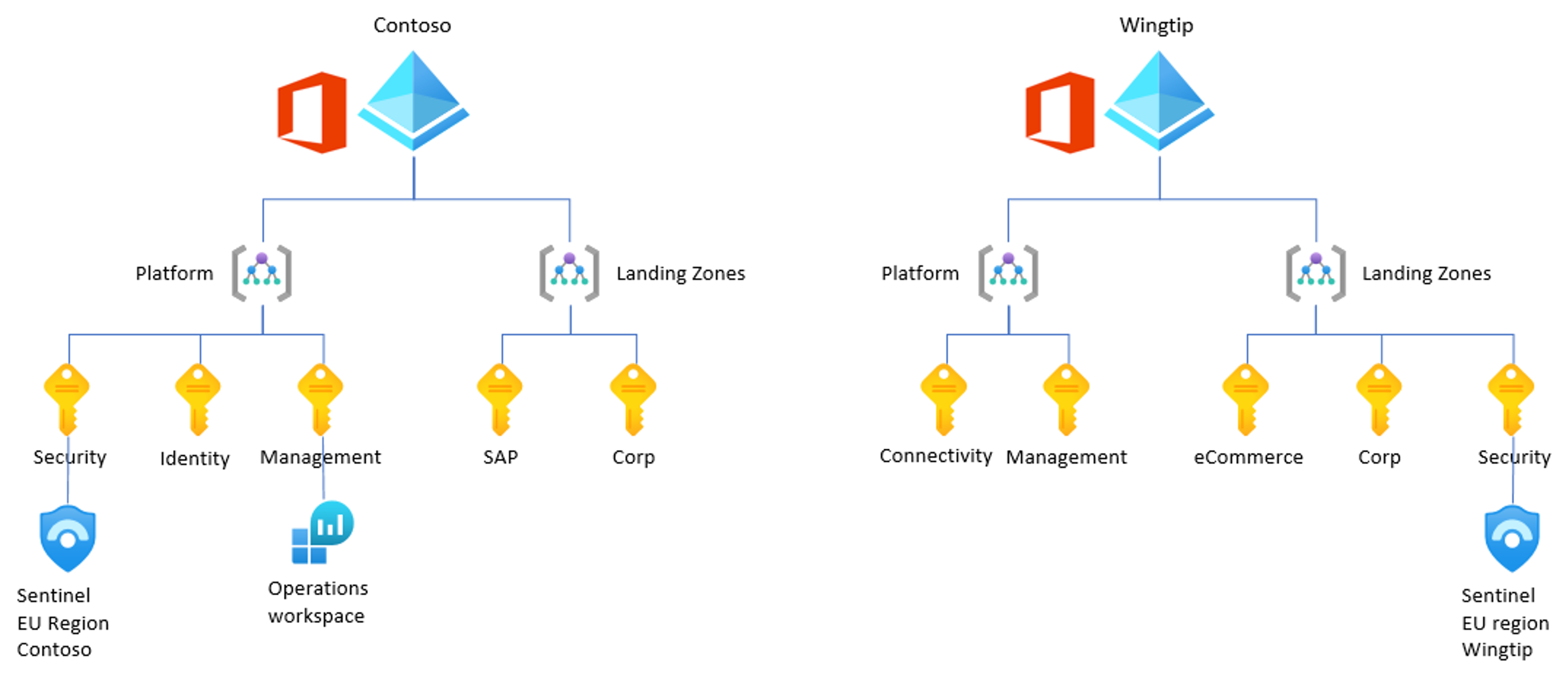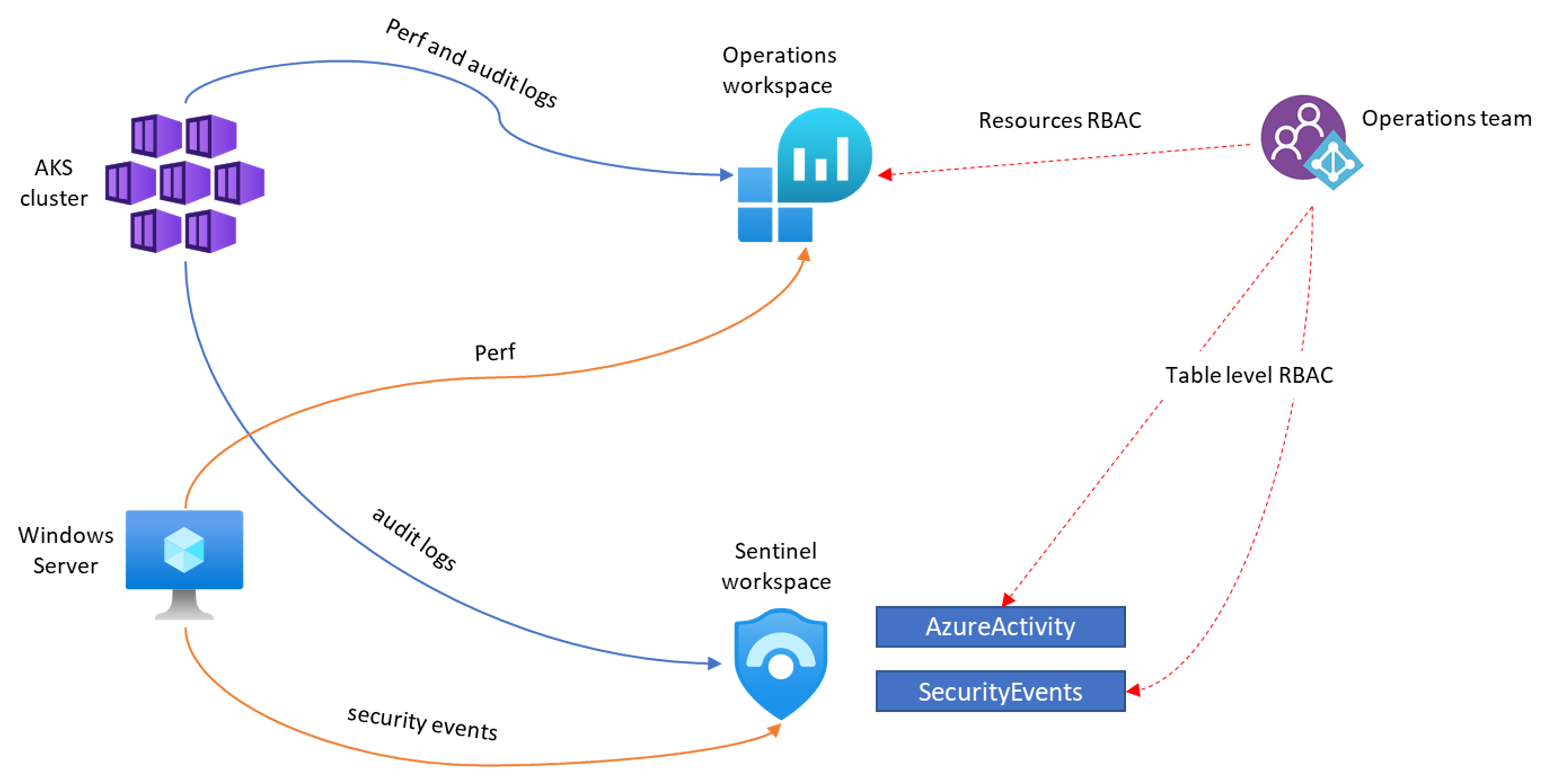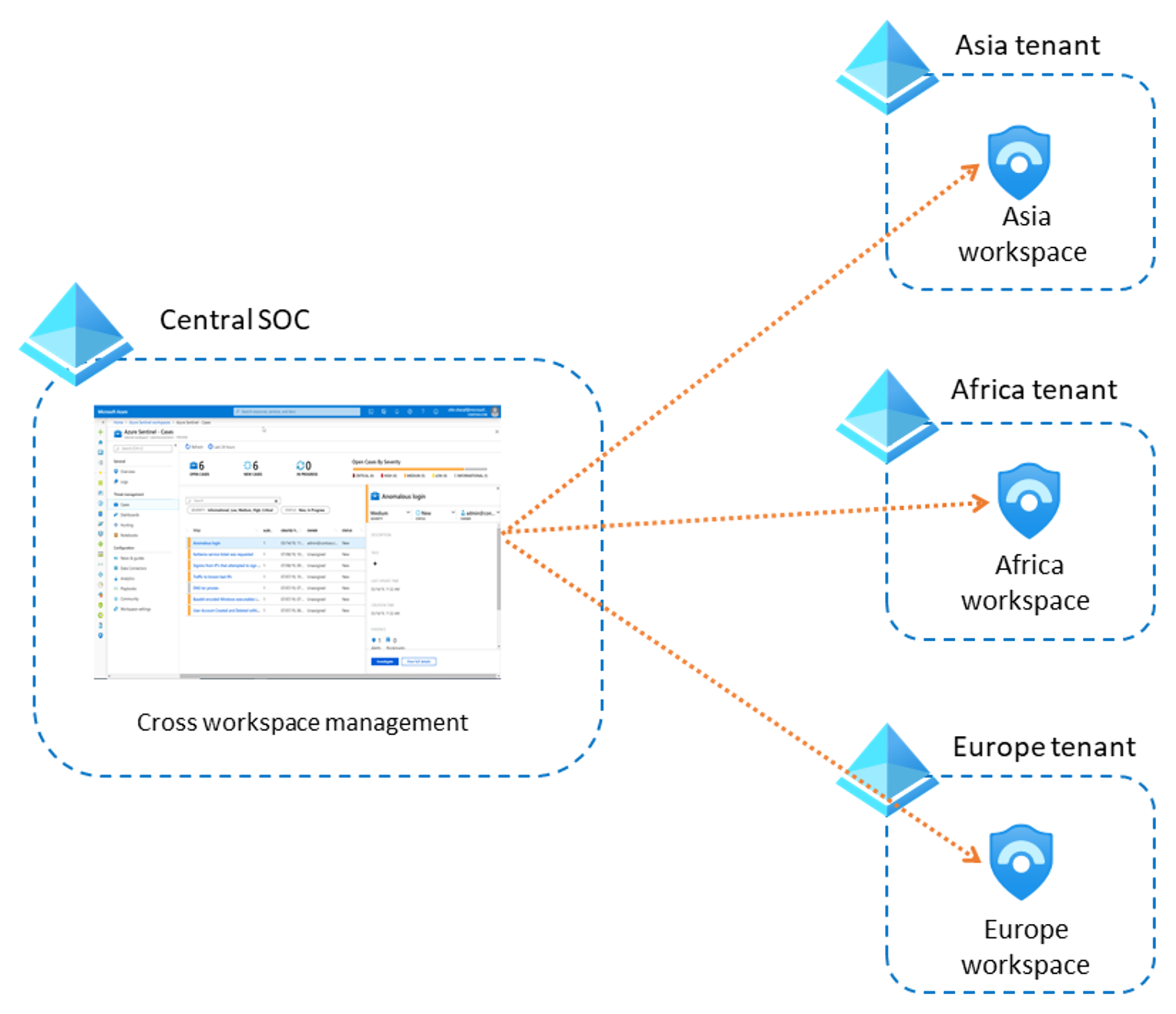Microsoft Sentinel sample workspace designs
This article describes suggested workspace designs for organizations with the following sample requirements:
- Multiple-tenants and regions, with European Data Sovereignty requirements
- Single tenant with multiple clouds
- Multiple tenants, with multiple regions and centralized security
The samples in this article use the Microsoft Sentinel workspace design decision tree to determine the best workspace design for each organization. For more information, see Microsoft Sentinel workspace architecture best practices.
This article is part of the Deployment guide for Microsoft Sentinel.
Sample 1: Multiple tenants and regions
The Contoso Corporation is a multinational business with headquarters in London. Contoso has offices around the world, with important hubs in New York City and Tokyo. Recently, Contoso has migrated their productivity suite to Office 365, with many workloads migrated to Azure.
Contoso tenants
Due to an acquisition several years ago, Contoso has two Microsoft Entra tenants: contoso.onmicrosoft.com and wingtip.onmicrosoft.com. Each tenant has its own Office 365 instance and multiple Azure subscriptions, as shown in the following image:

Contoso compliance and regional deployment
Contoso currently has Azure resources hosted in three different regions: US East, EU North, and West Japan, and strict requirement to keep all data generated in Europe within Europe regions.
Both of Contoso's Microsoft Entra tenants have resources in all three regions: US East, EU North, and West Japan
Contoso resource types and collection requirements
Contoso needs to collect events from the following data sources:
- Office 365
- Microsoft Entra sign-in and audit logs
- Azure Activity
- Windows Security Events, from both on-premises and Azure VM sources
- Syslog, from both on-premises and Azure VM sources
- CEF, from multiple on-premises networking devices, such as Palo Alto, Cisco ASA, and Cisco Meraki
- Multiple Azure PaaS resources, such as Azure Firewall, AKS, Key Vault, Azure Storage, and Azure SQL
- Cisco Umbrella
Azure VMs are mostly located in the EU North region, with only a few in US East and West Japan. Contoso uses Microsoft Defender for servers on all their Azure VMs.
Contoso expects to ingest around 300 GB/day from all of their data sources.
Contoso access requirements
Contoso’s Azure environment already has a single existing Log Analytics workspace used by the Operations team to monitor the infrastructure. This workspace is located in Contoso Microsoft Entra tenant, within EU North region, and is being used to collect logs from Azure VMs in all regions. They currently ingest around 50 GB/day.
The Contoso Operations team needs to have access to all the logs that they currently have in the workspace, which include several data types not needed by the SOC, such as Perf, InsightsMetrics, ContainerLog, and more. The Operations team must not have access to the new logs that are collected in Microsoft Sentinel.
Contoso's solution
The following steps apply the Microsoft Sentinel workspace design decision tree to determine the best workspace design for Contoso:
Contoso already has an existing workspace, so we can explore enabling Microsoft Sentinel in that same workspace.
Non-SOC data ingestion is less than 100 GB/day, so we can continue to step 2, and making sure to select the relevant option in step 5.
Contoso has regulatory requirements, so we need at least one Microsoft Sentinel workspace in Europe.
Contoso has two different Microsoft Entra tenants, and collects from tenant-level data sources, like Office 365 and Microsoft Entra sign-in and audit logs, so we need at least one workspace per tenant.
Contoso doesn't need charge-back, so we can continue with step 5.
Contoso does need to collect non-SOC data, although there isn't any overlap between SOC and non-SOC data. Also, SOC data accounts for approximately 250 GB/day, so they should use separate workspaces for the sake of cost efficiency.
Most Contoso's VMs are the EU North region, where they already have a workspace. Therefore, in this case, bandwidth costs aren't a concern.
Contoso has a single SOC team that will be using Microsoft Sentinel, so no extra separation is needed.
All members of Contoso's SOC team will have access to all the data, so no extra separation is needed.
The resulting Microsoft Sentinel workspace design for Contoso is illustrated in the following image:

The suggested solution includes:
A separate Log Analytics workspace for the Contoso Operations team. This workspace will only contain data that's not needed by Contoso’s SOC team, such as the Perf, InsightsMetrics, or ContainerLog tables.
Two Microsoft Sentinel workspaces, one in each Microsoft Entra tenant, to ingest data from Office 365, Azure Activity, Microsoft Entra ID, and all Azure PaaS services.
All other data, coming from on-premises data sources, can be routed to one of the two Microsoft Sentinel workspaces.
Sample 2: Single tenant with multiple clouds
Fabrikam is an organization with headquarters in New York City and offices all around the United States. Fabrikam is starting their cloud journey, and still needs to deploy their first Azure landing zone and migrate their first workloads. Fabrikam already has some workloads on AWS, which they intend to monitor using Microsoft Sentinel.
Fabrikam tenancy requirements
Fabrikam has a single Microsoft Entra tenant.
Fabrikam compliance and regional deployment
Fabrikam has no compliance requirements. Fabrikam has resources in several Azure regions located in the US, but bandwidth costs across regions aren't a major concern.
Fabrikam resource types and collection requirements
Fabrikam needs to collect events from the following data sources:
- Microsoft Entra sign-in and audit logs
- Azure Activity
- Security Events, from both on-premises and Azure VM sources
- Windows Events, from both on-premises and Azure VM sources
- Performance data, from both on-premises and Azure VM sources
- AWS CloudTrail
- AKS audit and performance logs
Fabrikam access requirements
The Fabrikam Operations team needs to access:
- Security events and Windows events, from both on-premises and Azure VM sources
- Performance data, from both on-premises and Azure VM sources
- AKS performance (Container Insights) and audit logs
- All Azure Activity data
The Fabrikam SOC team needs to access:
- Microsoft Entra sign-in and audit logs
- All Azure Activity data
- Security events, from both on-premises and Azure VM sources
- AWS CloudTrail logs
- AKS audit logs
- The full Microsoft Sentinel portal
Fabrikam's solution
The following steps apply the Microsoft Sentinel workspace design decision tree to determine the best workspace design for Fabrikam:
Fabrikam has no existing workspace, so continue to step 2.
Fabrikam has no regulatory requirements, so continue to step 3.
Fabrikam has a single-tenant environment. so continue to step 4.
Fabrikam has no need to split up charges, so continue to step 5.
Fabrikam will need separate workspaces for their SOC and Operations teams:
The Fabrikam Operations team needs to collect performance data, from both VMs and AKS. Since AKS is based on diagnostic settings, they can select specific logs to send to specific workspaces. Fabrikam can choose to send AKS audit logs to the Microsoft Sentinel workspace, and all AKS logs to a separate workspace, where Microsoft Sentinel isn't enabled. In the workspace where Microsoft Sentinel isn't enabled, Fabrikam will enable the Container Insights solution.
For Windows VMs, Fabrikam can use the Azure Monitoring Agent (AMA) to split the logs, sending security events to the Microsoft Sentinel workspace, and performance and Windows events to the workspace without Microsoft Sentinel.
Fabrikam chooses to consider their overlapping data, such as security events and Azure activity events, as SOC data only, and sends this data to the workspace with Microsoft Sentinel.
Bandwidth costs aren't a major concern for Fabrikam, so continue with step 7.
Fabrikam has already decided to use separate workspaces for the SOC and Operations teams. No further separation is needed.
Fabrikam does need to control access for overlapping data, including security events and Azure activity events, but there's no row-level requirement.
Security events and Azure activity events aren't custom logs, so Fabrikam can use table-level RBAC to grant access to these two tables for the Operations team.
The resulting Microsoft Sentinel workspace design for Fabrikam is illustrated in the following image, including only key log sources for the sake of design simplicity:

The suggested solution includes:
Two separate workspaces in the US region: one for the SOC team with Microsoft Sentinel enabled, and another for the Operations team, without Microsoft Sentinel.
The Azure Monitoring Agent (AMA), used to determine which logs are sent to each workspace from Azure and on-premises VMs.
Diagnostic settings, used to determine which logs are sent to each workspace from Azure resources such as AKS.
Overlapping data being sent to the Microsoft Sentinel workspace, with table-level RBAC to grant access to the Operations team as needed.
Sample 3: Multiple tenants and regions and centralized security
Adventure Works is a multinational company with headquarters in Tokyo. Adventure Works has 10 different sub-entities , based in different countries/regions around the world.
Adventure Works is Microsoft 365 E5 customer, and already has workloads in Azure.
Adventure Works tenancy requirements
Adventure Works has three different Microsoft Entra tenants, one for each of the continents where they have sub-entities: Asia, Europe, and Africa. The different sub-entities' countries/regions have their identities in the tenant of the continent they belong to. For example, Japanese users are in the Asia tenant, German users are in the Europe tenant and Egyptian users are in the Africa tenant.
Adventure Works compliance and regional requirements
Adventure Works currently uses three Azure regions, each aligned with the continent in which the sub-entities reside. Adventure Works doesn't have strict compliance requirements.
Adventure Works resource types and collection requirements
Adventure Works needs to collect the following data sources for each sub-entity:
- Microsoft Entra sign-in and audit logs
- Office 365 logs
- Microsoft Defender XDR for Endpoint raw logs
- Azure Activity
- Microsoft Defender for Cloud
- Azure PaaS resources, such as from Azure Firewall, Azure Storage, Azure SQL, and Azure WAF
- Security and windows Events from Azure VMs
- CEF logs from on-premises network devices
Azure VMs are scattered across the three continents, but bandwidth costs aren't a concern.
Adventure Works access requirements
Adventure Works has a single, centralized SOC team that oversees security operations for all the different sub-entities.
Adventure Works also has three independent SOC teams, one for each of the continents. Each continent's SOC team should be able to access only the data generated within its region, without seeing data from other continents. For example, the Asia SOC team should only access data from Azure resources deployed in Asia, Microsoft Entra Sign-ins from the Asia tenant, and Defender for Endpoint logs from it’s the Asia tenant.
Each continent's SOC team needs to access the full Microsoft Sentinel portal experience.
Adventure Works’ Operations team runs independently, and has its own workspaces without Microsoft Sentinel.
Adventure Works solution
The following steps apply the Microsoft Sentinel workspace design decision tree to determine the best workspace design for Adventure Works:
Adventure Works' Operations team has its own workspaces, so continue to step 2.
Adventure Works has no regulatory requirements, so continue to step 3.
Adventure Works has three Microsoft Entra tenants, and needs to collect tenant-level data sources, such as Office 365 logs. Therefore, Adventure Works should create at least Microsoft Sentinel workspaces, one for each tenant.
Adventure Works has no need to split up charges, so continue to step 5.
Since Adventure Works' Operations team has its own workspaces, all data considered in this decision will be used by the Adventure Works SOC team.
Bandwidth costs aren't a major concern for Adventure Works, so continue with step 7.
Adventure Works does need to segregate data by ownership, as each content's SOC team needs to access only data that is relevant to that content. However, each continent's SOC team also needs access to the full Microsoft Sentinel portal.
Adventure Works doesn't need to control data access by table.
The resulting Microsoft Sentinel workspace design for Adventure Works is illustrated in the following image, including only key log sources for the sake of design simplicity:

The suggested solution includes:
A separate Microsoft Sentinel workspace for each Microsoft Entra tenant. Each workspace collects data related to its tenant for all data sources.
Each continent's SOC team has access only to the workspace in its own tenant, ensuring that only logs generated within the tenant boundary are accessible by each SOC team.
The central SOC team can still operate from a separate Microsoft Entra tenant, using Azure Lighthouse to access each of the different Microsoft Sentinel environments. If there's no other tenant, the central SOC team can still use Azure Lighthouse to access the remote workspaces.
The central SOC team can also create another workspace if it needs to store artifacts that remain hidden from the continent SOC teams, or if it wants to ingest other data that isn't relevant to the continent SOC teams.
Next steps
In this article, you reviewed a set of suggested workspace designs for organizations.
Feedback
Coming soon: Throughout 2024 we will be phasing out GitHub Issues as the feedback mechanism for content and replacing it with a new feedback system. For more information see: https://aka.ms/ContentUserFeedback.
Submit and view feedback for